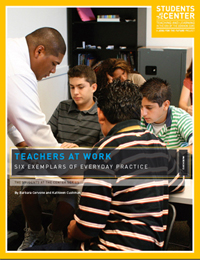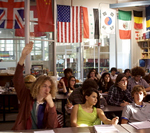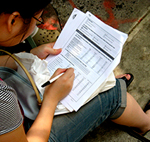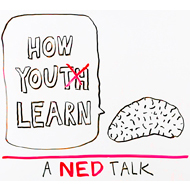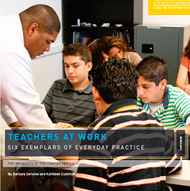

How Youth Learn: A Portfolio to Inform and Inspire Educators, Students, Parents & More
| From the Field | SHARE |
Teachers at Work: Six Exemplars of Everyday Practice by Barbara Cervone and Kathleen Cushman, Students at the Center, Jobs for the Future/Nellie Mae Education Foundation, 2012 What does teaching look like when it truly centers on the student’s learning needs? What conditions foster and support such teaching? What kind of learning environments give all students, and especially underserved youth, access to an education that results in the skills, knowledge, and habits they will need for a successful and productive adult life in our rapidly changing world? How can schools and teachers in the very diverse population served by U.S. schools adapt their structures and practices so as to coach the ongoing social, emotional, and intellectual development of all students? As writers, researchers, journalists, school founders, and school reformers, we have asked (and been asked) these questions again and again. The bottom line always comes down to this: “How do we challenge students to do their best?” For answers, we turned to six schools that, each in its own way, are exemplars of student-centered learning: Alief Early College High School in Alief, Texas; Bronx International High School; Dayton Early College Academy in Dayton, Ohio; MetWest in Oakland, California; NYC iSchool; and Noble High School in North Berwick, Maine. DOWNLOAD PDF SEE ALSO: "You're Constantly Revising Yourself": The Dispositions of a Student-Centered Teacher |
Learning by Heart: High Schools Where Social-Emotional Learning Is Core by Barbara Cervone and Kathleen Cushman, NoVo Foundation, coming December 2013 What would it take to weave social and emotional learning (SEL) into the daily fabric of our nation’s high schools? What distinct practices, programs, and structures help schools embed SEL into ongoing teaching and learning? How do schools scaffold — and distribute — the gradual coaching adolescents need in order to practice and gain desired dispositions and skills over their developmental trajectory? What formal and informal measures can schools use to assess student progress in relation to social and emotional learning? As part of a yearlong project, we are documenting daily practice in seven American high schools that, by their own design, put social-emotional learning at their core: Common Ground High School in New Haven, CT; Roberto Clemente High School and Fenger High School in Chicago; East Side Community School in NYC; Oakland International High School in Oakland, CA; Quest Early College High School in Humble, TX; Springfield Renaissance School in Springfield, MA. |
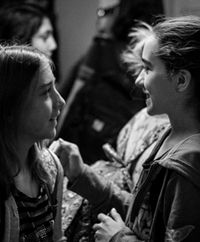 |
From the WKCD Archives
 |
For more than a dozen years, WKCD has gathered and published on WKCD.org hundreds of stories of "powerful learning with public purpose" by our nation's adolescents, We've led national projects that engage students as action researchers in their schools and communities. Here is a small sample from our WKCD archives. We refresh this list regularly, especially with new stories about classroom practices that bring out the best in teenage learners. |
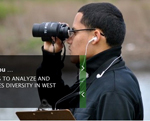 |
Common Ground High School: A Decidedly Uncommon School Less than four miles from downtown New Haven, Common Ground High School, the nation’s first "green” charter school, is raising a new generation of environmental stewards — along with crops and livestock — on the once-abandoned farmland that surrounds the school. More than 93 percent of Common Ground graduates, many from poor neighborhoods across New Haven, go on to college and a third end up in environment-related majors. Graduates also carry with them a deep commitment to public service. Everything about Common Ground High School is decidedly uncommon. |
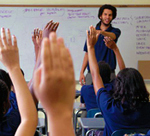 |
NYC Students Weave Student Voice into the Fabric of Their Schools The NYC Department of Education calls its approach to ranking public schools "hard-nosed accountability." says Aravis, a senior at Vanguard High School in Manhattan. But to Aravis and her peers in the Student Voice Collaborative (SVC), this approach overlooks a crucial factor in the accountability equation: the experience of students themselves. SVC students, and their coordinator, Ari Sussman, have much to say about student voice — and a rubric for schools to use to take stock of their efforts to engage students meaningfully in everyday instruction. |
 |
“I’ll be talking about courage and Common Sense with Thomas Paine,” begins Carriola Chambers, 16, as she steels her nerves. It’s presentation day at Facing History School (FHS) in mid-Manhattan and students like Carriola are demonstrating to small panels of teachers and peers how they have advanced their “habits of learning” over the quarter. Started in 2005 with support from the Boston-based Facing History and Ourselves, the school boasts an idealistic group of students and faculty, a coherent vision, and a passion for the human story. |
|
Students as Allies in School Reform In many classrooms across the country, neither students nor teachers feel very smart. The refrains are familiar.School is boring, it’s hard to see a connection between what we’re taught and the real world, students complain. We can’t do everything, teachers respond. It’s tough to reach kids whose backgrounds are so different from our own. What if teachers and students became steady allies rather than frequent adversaries? What would it take for students to become stakeholders not just in their own success but also in that of their teachers and schools? In 2003,WKCD explored these questions with students and teachers in five cities. We co-created school-based surveys about the conditions of learning, then supported dialogue and constructive action around the results. Since then, the surveys we used in 2003-2004 have been downloaded more than 150,000 times from WKCD.org — by teachers, teacher educators, graduate students, and schools, |
 |
Student Learning in Small Schools: An Online Portfolio In 2002, when the Bill & Melinda Gates Foundation launched an initiative to bring small schools to scale across the country, WKCD partnered with the foundation to create an online portfolio of student learning in four of the small schools best known at the time: Minnesota New Country School (Henderson, MN), The Met School (Providence, RI), Urban Academy (New York City), and High Tech High (San Diego, CA). We started by exploring the commonalities of student learning in these four schools. Like other ambitious small schools across the country, they share several commitments. They pair high expectations with diverse learning opportunities, personalization with community building. They value student responsibility along with adult attentiveness, real-world problem solving along with public demonstrations of student learning. Yet we were just as interested in their distinctions. What does each school uniquely ask of its students? What does it most emphasize and prize? The differences, we imagined, reflect the schools’ founders but also their contexts: self-reliant rural Minnesota; tight-knit blue-collar Rhode Island; brash and brainy Manhattan; entrepreneurial Southern California. |
